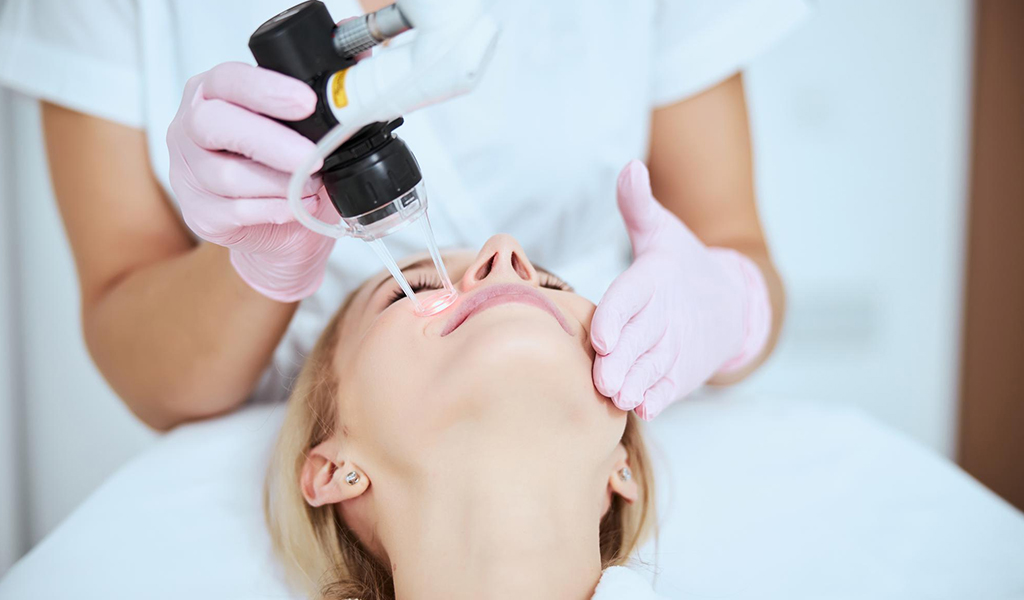CO2 RESURFACING

WHAT IS CO2 RESURFACING?
A CO2 Fractional resurfacing laser is carbon dioxide laser which precisely removes deep outer layers of damaged skin and stimulates the regeneration of healthy skin underneath. The CO2 treats fine to moderately deep wrinkles, photo damage, scarring, skin tone, texture, crepiness, and laxity. A fractionated CO2 treatment helps regenerate new collagen and consequently more youthful, healthier looking skin while allowing for shorter healing times and safer treatments than traditional methods. This is an ablative treatment and downtime should be expected.
WHAT ARE THE BENEFITS OF CO2 RESURFACING?
• Minimizes sun damage, acne scars, and fine lines
• Improves skin texture and evens skin tone
• Stimulates collagen for firmer, more youthful skin
• May help treat skin lesions
• Creates a firmer and more youthful skin appearance
HOW DOES IT WORK?
Carbon dioxide laser beams penetrate the top skin layers through micro channels reaching into the dermis. It creates tiny microscopic areas of thermal damage that stimulate new collagen production and replace damaged skin surface by new epidermal cells.
HOW DOES CO2 DIFFER ROM OTHER LASER TREATMENTS?
The major difference between IPL treatments and Fractionated CO2 Laser Resurfacing is ablation. Fractional CO2 laser is a deep, ablative treatment for more intense cellular turnover. CO2 laser resurfacing is the original and most in-depth cosmetic laser treatment on the market. It is an ablative procedure, meaning that the laser energy destroys the outer layer of damaged cells to encourage new collagen production and prompt the body to create fresh, new skin. Recovery can take one to several weeks, but the results can be dramatic. Other lasers may be lighter or non ablative and do not yield as significant results.
IS CO2 RESURFACING PAINFUL?
Patients and doctors commonly compare the sensation felt during most laser treatments to a rubber band snapping against the skin. However, what laser resurfacing feels like depends on the depth and area of treatment and an individual’s tolerance for pain. Deeper CO2 laser treatments may require topical or local anesthetic injections, or intravenous sedation to keep a patient comfortable. Some non-ablative laser treatments(where the laser passes through the skin without removing layers) cause little-to-no pain and require only a topical numbing cream to offset discomfort. These are nice alternatives but typically cannot provide as impactful results and many more sessions are required.
WHEN WILL I SEE RESULTS AND HOW LONG DO THEY LAST?
Initial results will be apparent within weeks of treatment. Full results, however, can be seen 3-6 months after the initial treatment, once the skin has completely healed. Improvements from a CO2 laser procedure may be seen for many years after treatment.

HOW MANY TREATMENTS WILL I NEED?
Typically 1 session may be sufficient depending on your individualized desired results. Additional treatments may be required for more complex skin issues.
HOW LONG DOES A TREATMENT TAKE?
Sessions generally take approximately 1 Hour based on the area being treated. For patients requiring more intensive sessions or if combined with RF Microneedling, the duration of a session may run up to 2-2.5 Hours.
HOW TO CARE FOR YOUR SKIN AFTER TREATMENT?
An after care kit is included with your treatment and instructions will be provided.
WILL I NEED TO TAKE TIME OFF?
Yes, there should be 3-7 days of downtime depending on the intensity of treatment.
AM I A CANDIDATE FOR CO2 RESURFACING?
Fitzpatrick Skin Types are typically candidates for this service depending on their medical history. Patients with an immune system disorder, connective tissue disorder or other similar health issues need to consult with their medical professional prior to getting a laser skin resurfacing treatment. While it still may be possible to get treated, the CO2 fractional laser recovery timeline could be much longer if you have one of these disorders or other health complications. Your medical professional will determine the safety of the treatment and make the best recommendation based on your overall health.
WHAT ARE THE RISKS INVOLVED WITH THIS TREATMENT?
• Milia, which are small white bumps or cysts, may appear in the laser-treated areas during healing. These
may be removed by gentle cleansing with a washcloth or by a dermatologist in the office by nicking the
surface with a blade and expressing the cyst material out of the skin.
• Acne flares may occur after laser resurfacing. This may resolve on its own or can be treated with
conventional acne therapies.
• Hyperpigmentation, and more rarely, hypopigmentation, may result in the laser-treated areas. In
general, the hyperpigmented areas may be treated with bleaching cream to ease fading of the pigment.
Hypopigmentation is more difficult to treat.
• Reactivation of a herpes simplex cold sore may occur, especially after laser resurfacing around the mouth.
This can be prevented by giving an antiviral medicine prior to the surgery and continuing it for 7 to 10 days
post-procedure.
• Bacterial infections can be prevented by taking an antibiotic prior to the treatment and continuing for 7 to 10
days post-procedure.
• Postoperative swelling is to be expected and is lessened by administration of intramuscular steroids.
Patients are encouraged to sleep on an extra pillow at night to help reduce the swelling. Ice pack application
is also helpful in the first 24 to 48 hours.
• Scarring, although rare, may occur in laser-treated areas.
• Quitting smoking is highly recommended because of its documented harmful effects on the healing
process.
Contact Us Today To Find Out If You Are A Candidate For CO2 Laser Resurfacing!
